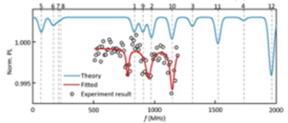Home > Press > The USTC realizes In situ electron paramagnetic resonance spectroscopy using single nanodiamond sensors
 |
| experimental results
CREDIT USTC |
Abstract:
Teams led by Prof. DU Jiangfeng, Prof. SHI Fazhan and Prof. KONG Fei from the University of Science and Technology of China (USTC) of the Chinese Academy of Sciences (CAS) used the Nitrogen-Vacancy (NV) center inside a single nanodiamond for quantum sensing to overcome the problem of random particle rotation.
The USTC realizes In situ electron paramagnetic resonance spectroscopy using single nanodiamond sensors
Hefei, China | Posted on November 3rd, 2023
The study was published on Oct. 7th in Nature Communications.
It is an important goal to detect and analyze molecules under physiological in situ conditions in the field of life sciences. Only by observing biomolecules under this condition can we reveal conformation changes when they realize physiological functions.
Thanks to its high sensitivity, good biocompatibility, and the characteristics of magnetic resonance detection of single molecules at room temperature atmosphere, the NV center quantum sensor is rather suitable for physiological in situ detection than traditional magnetic spectrum resonance instruments.
However, the results of tracking the movement of nanodiamond in living cells show that it rotates randomly both inside the cell and on the cell membrane, making the current common magnetic resonance detection methods ineffective.
To solve this problem, the research team designed an amplitude-modulation sequence, which will generate a series of equally spaced energy levels on the NV center.
When the energy level of the NV center matches the energy level of the measured target, resonance will occur and the state of the NV center will change.
By scanning the modulation frequency, the electron paramagnetic resonance (EPR) spectroscopy of the target can be obtained, and the position of the spectral peak is no longer affected by the spatial orientation of the NV center.
In this work, the ions in the solution environment of nanodiamond were measured by EPR spectroscopy under the condition of in situ. The research team simulated the movement of nanodiamonds in the cell to detect the solution of oxygen vanadium ions.
When there is rotation of nanodiamond, it is difficult to conduct accurate quantum manipulation of NV centers, but zero-field EPR spectrum of oxo-vanadium ions can still be measured.
This result proves in principle that it is feasible to use NV center in nanodiamond to realize the detection of intracellular physiological in-situ magnetic resonance.
The oxygen vanadium ions detected in this work itself have biological functions. The ultra-fine constant of oxygen vanadium ions can be analyzed and obtained by the EPR spectrum measured by a single moving nanodiamond.
The research team has previously relaxed the detection conditions of single-molecular magnetic resonance detection from solid conditions to aqueous solution environment, and this work has further promoted it to the in situ environment.
####
For more information, please click here
Contacts:
Jane Fan
University of Science and Technology of China
Copyright © University of Science and Technology of China
If you have a comment, please Contact us.
Issuers of news releases, not 7th Wave, Inc. or Nanotechnology Now, are solely responsible for the accuracy of the content.
News and information
![]()
Nanoparticle quasicrystal constructed with DNA: The breakthrough opens the way for designing and building more complex structures November 3rd, 2023
![]()
What a 2D quantum superfluid feels like to the touch November 3rd, 2023
Quantum Physics
![]()
What a 2D quantum superfluid feels like to the touch November 3rd, 2023
![]()
Twisted science: NIST researchers find a new quantum ruler to explore exotic matter October 6th, 2023
![]()
Discovery made by University of Warsaw scientists may enable network interface for quantum computers October 6th, 2023
Imaging
![]()
Observation of left and right at nanoscale with optical force October 6th, 2023
Possible Futures
![]()
Light guide plate based on perovskite nanocomposites November 3rd, 2023
![]()
Charged molecular beasts the basis for new compounds: Researchers at Leipzig University use aggressive fragments of molecular ions for chemical synthesis November 3rd, 2023
![]()
Study on Magnetic Force Microscopy wins 2023 Advances in Magnetism Award: Analysis of finite size effects reveals significant consequences for density measurements November 3rd, 2023
![]()
Ferroelectrically modulate the Fermi level of graphene oxide to enhance SERS response November 3rd, 2023
Discoveries
![]()
Nanoparticle quasicrystal constructed with DNA: The breakthrough opens the way for designing and building more complex structures November 3rd, 2023
Announcements
![]()
Light guide plate based on perovskite nanocomposites November 3rd, 2023
![]()
Charged molecular beasts the basis for new compounds: Researchers at Leipzig University use aggressive fragments of molecular ions for chemical synthesis November 3rd, 2023
![]()
Study on Magnetic Force Microscopy wins 2023 Advances in Magnetism Award: Analysis of finite size effects reveals significant consequences for density measurements November 3rd, 2023
![]()
Ferroelectrically modulate the Fermi level of graphene oxide to enhance SERS response November 3rd, 2023
Interviews/Book Reviews/Essays/Reports/Podcasts/Journals/White papers/Posters
![]()
Nanoparticle quasicrystal constructed with DNA: The breakthrough opens the way for designing and building more complex structures November 3rd, 2023
Tools
![]()
Ferroelectrically modulate the Fermi level of graphene oxide to enhance SERS response November 3rd, 2023
![]()
Observation of left and right at nanoscale with optical force October 6th, 2023
![]()
New single-photon Raman lidar can monitor for underwater oil leaks: System could be used aboard underwater vehicles for many applications June 30th, 2023










